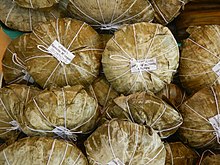 | |
| Alternative names | Binangol |
|---|---|
| Course | Dessert |
| Place of origin | Philippines |
| Region or state | Leyte, Samar |
| Main ingredients | giant taro, condensed milk, coconut milk, sugar, egg |
Binagol is a Filipino sweet steamed delicacy of the Waray people made from mashed giant taro corms, condensed milk, sugar, coconut milk, and egg yolks. It is distinctively placed in half of a coconut shell and then wrapped in banana leaves and twine. The name means "placed in a coconut shell", from the Visayan bagol (coconut shell). Binagol traditionally uses the corms of the giant taro (locally known as talyan or talian); however, the corms of the taro (known in Tagalog as gabi and in Eastern Visayas, where the delicacy originates, as gaway) is also alternatively used.[1][2][3][4] It is a type of nilupak.
See also
[edit]References
[edit]- ^ Piccio, Belle. "Binagol: A Sweet Surprise in a Coconut Shell". ChoosePhilippines. Archived from the original on May 14, 2019. Retrieved April 9, 2019.
- ^ "The Sweet Binagol of Leyte and Samar". VisitPinas.com. Archived from the original on April 11, 2019. Retrieved April 9, 2019.
- ^ "Binagol (or Binangol)". Kawaling Pinoy Tasty Recipes. Retrieved April 9, 2019.
- ^ "Leyte Pasalubong". Our Awesome Planet. Retrieved April 9, 2019.

Well, that’s interesting to know that Psilotum nudum are known as whisk ferns. Psilotum nudum is the commoner species of the two. While the P. flaccidum is a rare species and is found in the tropical islands. Both the species are usually epiphytic in habit and grow upon tree ferns. These species may also be terrestrial and grow in humus or in the crevices of the rocks.
View the detailed Guide of Psilotum nudum: Detailed Study Of Psilotum Nudum (Whisk Fern), Classification, Anatomy, Reproduction